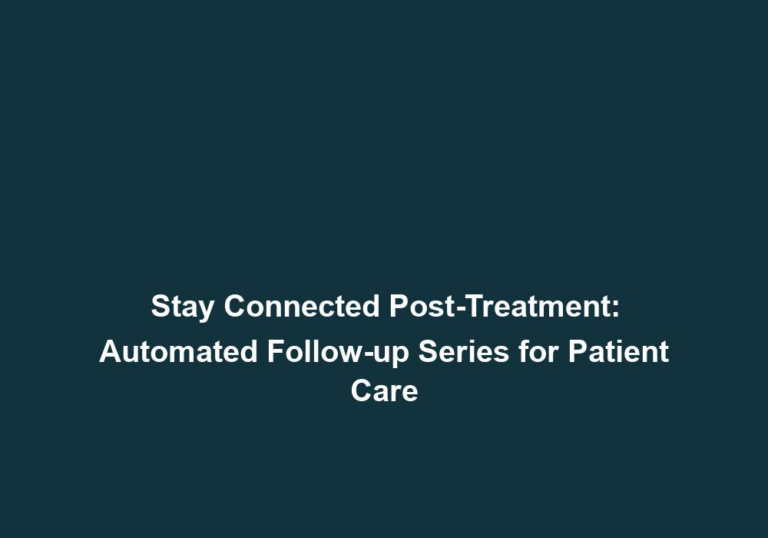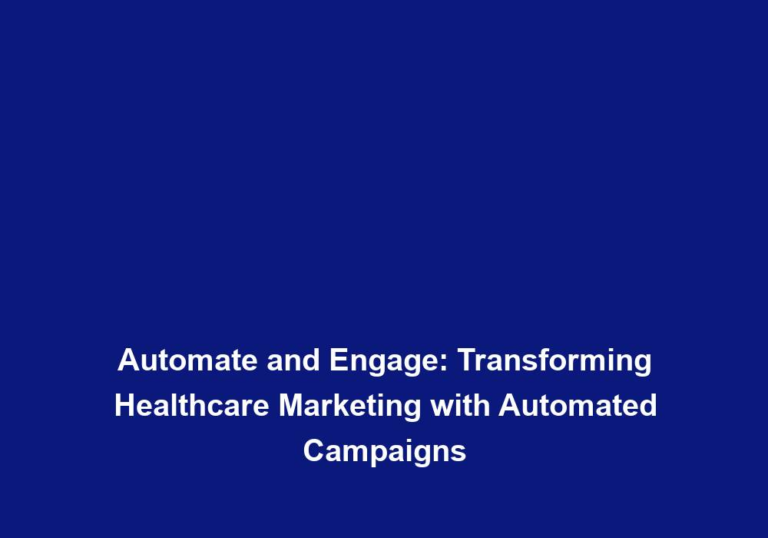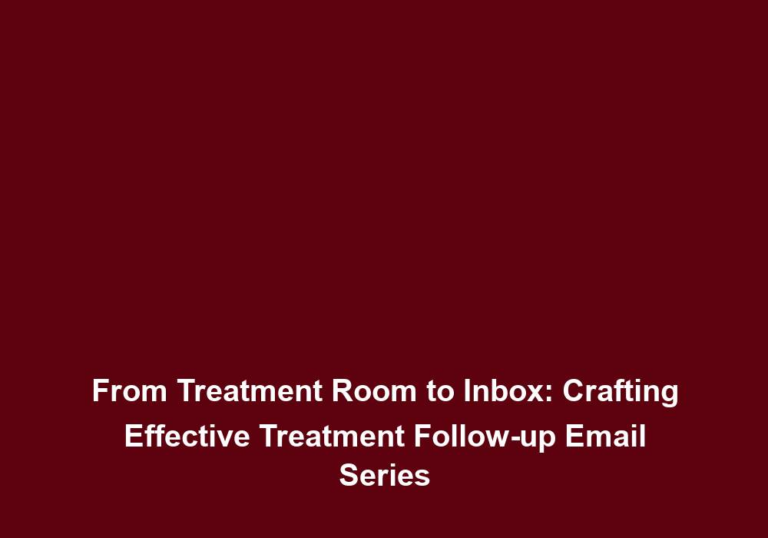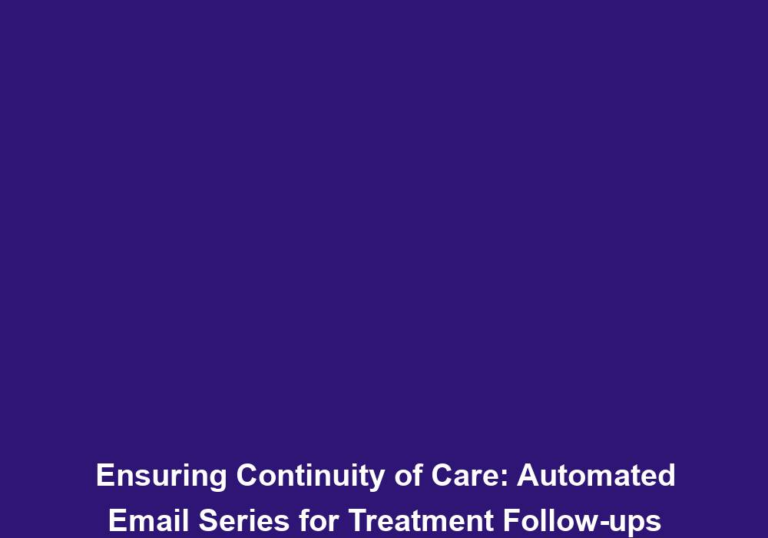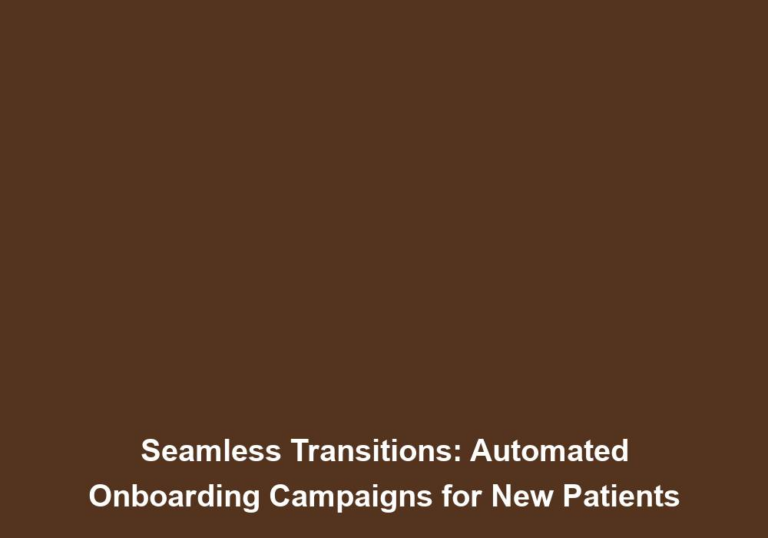First Impressions Matter: Streamlined New Patient Onboarding with Automated Campaigns
In today’s highly competitive healthcare industry, creating a positive and seamless experience for new patients is of utmost importance. The first impression they have of your practice can significantly impact their decision to continue seeking your services. To ensure a smooth onboarding process and make a lasting impression, consider implementing an automated campaign. By streamlining the new patient onboarding process, you can enhance efficiency, increase patient satisfaction, and ultimately improve your practice’s reputation.
Why Automated Campaigns?
Automated campaigns provide a systematic approach to new patient onboarding. By leveraging technology and automation tools, healthcare practices can deliver consistent, personalized, and timely communication to patients throughout their onboarding journey. This not only saves time and resources but also ensures that no crucial steps are overlooked. Here are some key benefits of implementing automated campaigns for new patient onboarding:
-
Efficiency: Automating repetitive tasks, such as sending appointment reminders, gathering patient information, and providing pre-visit instructions, saves valuable staff time. This allows your team to focus on more meaningful patient interactions. With automated campaigns, you can reduce the administrative burden on your staff and allocate their time towards delivering high-quality patient care.
-
Consistency: Automated campaigns ensure that each new patient receives the same high-quality experience. By standardizing the onboarding process, you can deliver consistent messaging, set expectations, and reduce the likelihood of errors or omissions. Consistency in communication helps build trust and reliability, which are essential for establishing strong patient-provider relationships.
-
Personalization: While automation streamlines the process, it doesn’t mean sacrificing personalization. With the right tools, you can tailor messages and content to each patient’s specific needs, preferences, and demographics. Personalization enhances patient engagement and fosters a sense of trust and individualized care. By collecting and analyzing patient data, you can provide targeted information and recommendations that resonate with each patient.
-
Timeliness: Automated campaigns enable you to deliver information and instructions at the right time. Whether it’s sending pre-appointment reminders, sharing educational materials, or requesting feedback, automation ensures that patients receive relevant communications when they need them the most. Timely communication helps patients feel supported and informed, leading to a better overall experience.
-
Improved Patient Satisfaction: A smooth onboarding experience positively impacts patient satisfaction. By automating key touchpoints, you can address patient concerns promptly, provide comprehensive information, and make patients feel valued and supported from the start. Enhanced patient satisfaction not only leads to increased retention but also generates positive word-of-mouth referrals, benefiting your practice in the long run.
Key Elements of an Automated Campaign for New Patient Onboarding
To create an effective automated campaign for new patient onboarding, consider incorporating the following key elements:
1. Welcome Email or Text Message
A personalized welcome message sets the tone for the patient’s journey with your practice. It should express gratitude for choosing your services, introduce key team members, and outline the next steps. Additionally, provide relevant contact information, office hours, and any necessary forms or paperwork to be completed prior to the visit. This initial communication helps establish a warm and welcoming atmosphere, making patients feel valued and informed.
2. Pre-Appointment Reminders
Automated reminders ensure that patients don’t forget their upcoming appointments. Send reminders via email, SMS, or even automated phone calls. Include appointment details, location, and any specific instructions for preparation. These reminders not only reduce the likelihood of no-shows but also demonstrate your commitment to patient care by ensuring that patients are well-prepared for their visits.
3. Online Patient Registration
Simplify the registration process by providing patients with a secure online portal to complete necessary forms and provide medical history information. This saves time during the actual visit and allows healthcare providers to review patient history beforehand, improving the efficiency of the appointment. Additionally, consider incorporating a progress tracker that allows patients to see how far they are in the registration process, enhancing transparency and reducing patient anxiety.
4. Educational Resources
Share educational materials with new patients to empower them with relevant information about their condition, treatment options, or preventive care. This can be done through email newsletters, blog posts, or links to reputable healthcare websites. Educating patients not only boosts their confidence but also promotes active participation in their own healthcare journey. Consider creating a comprehensive library of resources that cover various topics, allowing patients to access information that aligns with their specific needs.
5. Post-Visit Follow-up
After a patient’s initial visit, it’s crucial to follow up to gauge their satisfaction, address any concerns, and schedule any necessary follow-up appointments. Automated post-visit surveys or personalized emails can help gather feedback and foster ongoing patient engagement. Additionally, consider providing aftercare instructions or additional resources based on the nature of the visit, ensuring that patients have the necessary information to continue their care effectively.
6. Social Media Integration
Integrate your automated campaign with your practice’s social media channels to extend your reach, engage with patients, and share relevant updates or health tips. Encourage patients to follow or like your pages, and provide them with valuable content that keeps them informed and connected to your practice. Consider creating interactive posts or hosting live Q&A sessions to encourage patient interaction and create a sense of community.
Conclusion
By implementing an automated campaign for new patient onboarding, healthcare practices can make a positive and lasting impression on their patients. Streamlining the onboarding process through automation improves efficiency, enhances patient satisfaction, and fosters an environment of personalized care. Remember, first impressions matter, so invest in creating a seamless onboarding experience that sets the stage for a long-term patient-provider relationship. With the right tools and strategies in place, you can establish a competitive edge in the healthcare industry and cultivate strong patient loyalty.


